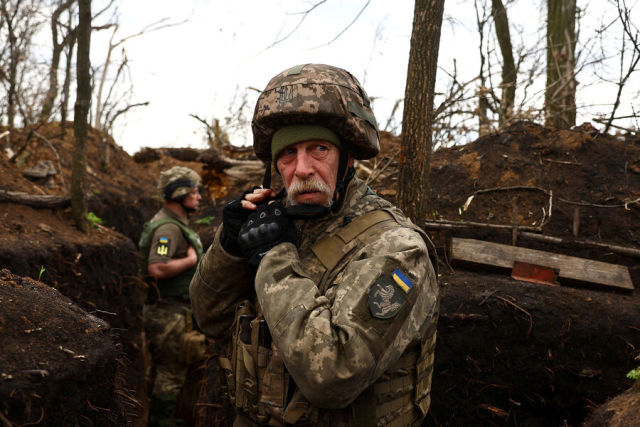NYT: in the leak of the US special services, there is data on the transfer of elite units of the Armed Forces of Ukraine to Artemovsk The New York Times and The Washington Post published new materials about intelligence data that leaked to the Internet in late February - early March.
NYT says that the documents contained information about Ukraine's plans in Artemovsk, as well as Washington's assessment of the state of the Armed Forces. In addition, they listed alleged actions on the part of Russia. WP writes that high-ranking officials, having learned about the "drain" of information, "became enraged."
The American media continue to discuss the American intelligence data that got into the network. Part of them, [...] The New York Times reports, concerns the situation in Artemovsk (the Ukrainian name is Bakhmut).
Most of the papers are operational summaries compiled by the Joint Chiefs of Staff of the United States on the basis of intelligence. They indicate that the American side is monitoring the actions of the top military and political leadership of Ukraine in order to "have a clear idea" of the country's strategy.
"As of February 25, Ukrainian forces were practically surrounded by Russian troops in Bakhmut," the newspaper quotes an excerpt from the document.
The report notes that the head of the Main Intelligence Directorate (GUR) of Ukraine, Kirill Budanov, at that time assessed the situation of the Ukrainian troops as "catastrophic". At the same time, he proposed to deploy elite units under his command in Bakhmut for two weeks in order to push back Russian troops and prevent them from blocking supply routes.
The newspaper has studied more than 50 pages that relate to the activities of the US National Security Agency, the CIA, the Pentagon Intelligence Agency and the National Directorate of Military Space Intelligence.
It is indicated that the published documents contain data on US surveillance of its allies. "Although this is unlikely to surprise the officials of these countries, the publication of such eavesdropping always complicates relations with key partners, such as South Korea, whose assistance is needed to supply Ukraine with weapons," writes The New York Times.
Ukrainian officials themselves claim that this data is a fake aimed at "sowing distrust between Ukraine's partners."
An intelligence officer of one of the Western countries, in a conversation with the NYT, expressed concern that Washington could restrict access to intelligence by allies. Some of the leaked documents were marked "Secret/Noforn", which indicates the content of data not intended for transfer to other countries.
"According to the official, in order for various agencies to provide materials to each other, trust and guarantees are required that certain confidential information will be kept secret," the NYT notes.
The publication also claims that documents have leaked to the network that contain "daily warnings from American intelligence agencies in real time about the timing of Moscow's strikes and even about its specific goals." According to the publication, the intelligence work allows "the United States to transmit important information to Ukraine on how to protect itself."
The publication, with reference to the documents, notes that "almost every Russian security service has somehow been infiltrated by the United States." As an example, the newspaper points to an entry marked "Top Secret". It allegedly "discusses the plans of the Russian General Staff to counter the tanks that NATO countries supplied to Ukraine, including the creation of various "fire zones" and the beginning of training of Russian soldiers to the vulnerabilities of various allied tanks."
The materials also reveal how Washington assesses the state of the Armed Forces, "who themselves are in a difficult situation." "The leaked material, dated late February and early March, but discovered in recent days on social networks, notes an acute shortage of ammunition for air defense and discusses the successes achieved by Russian troops in the area of the eastern city of Bakhmut," the American newspaper says.
On Friday, April 7, the FBI launched an investigation, which, according to senior US officials, will soon determine the source of the leak. One of the NYT sources doubted that this could be done quickly, since "hundreds, if not thousands of US military and other government officials have the permits necessary to gain access to documents."
In April, two more batches of intelligence data appeared on social networks. In addition to Ukraine, they talk about American national security issues in the Middle East and China.
The Washington Post draws attention to the fact that "officials learned that the documents became publicly available around the time the New York Times first reported the leak, that is, on Thursday."
According to the newspaper, American officials and their allies "were shocked and in some cases enraged" because of the secret documents that had previously been published on the Internet. In particular, they indicated details of how "The United States spies on friends and enemies," two interlocutors of the publication said that the Pentagon leadership restricted the transfer of intelligence after the leak. They did not explain what exactly the measure was, but stressed that it was "extremely strict." One of the sources told the publication that the reaction of the US defense Department indicates a "high level of panic" among the leadership of the ministry.
WP notes that some of the documents most likely came from the Pentagon. They contain "tactical information about the war in Ukraine, including the country's combat capabilities," the publication emphasizes. The review of the fighting in the Donbass on February 23 predicts an "exhausting campaign of exhaustion" on the part of Russia, which "probably leads to a deadlock preventing Moscow from capturing the entire region in 2023."
In addition, netizens were able to find out "where the CIA recruited agents involved in closed conversations of world leaders," and "what types of satellite images the United States uses to track Russian troops." In particular, we are talking about advanced technologies that are unlikely to be advertised somewhere.
Angelina Milchenko

